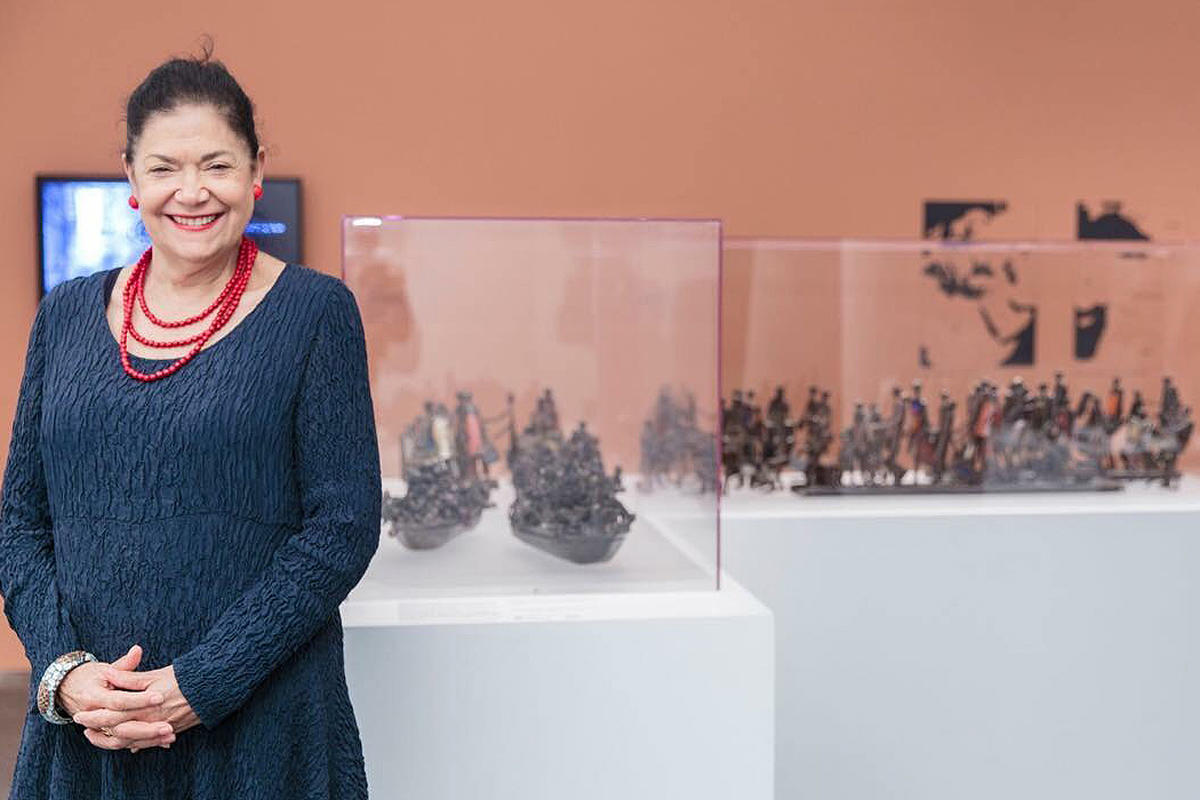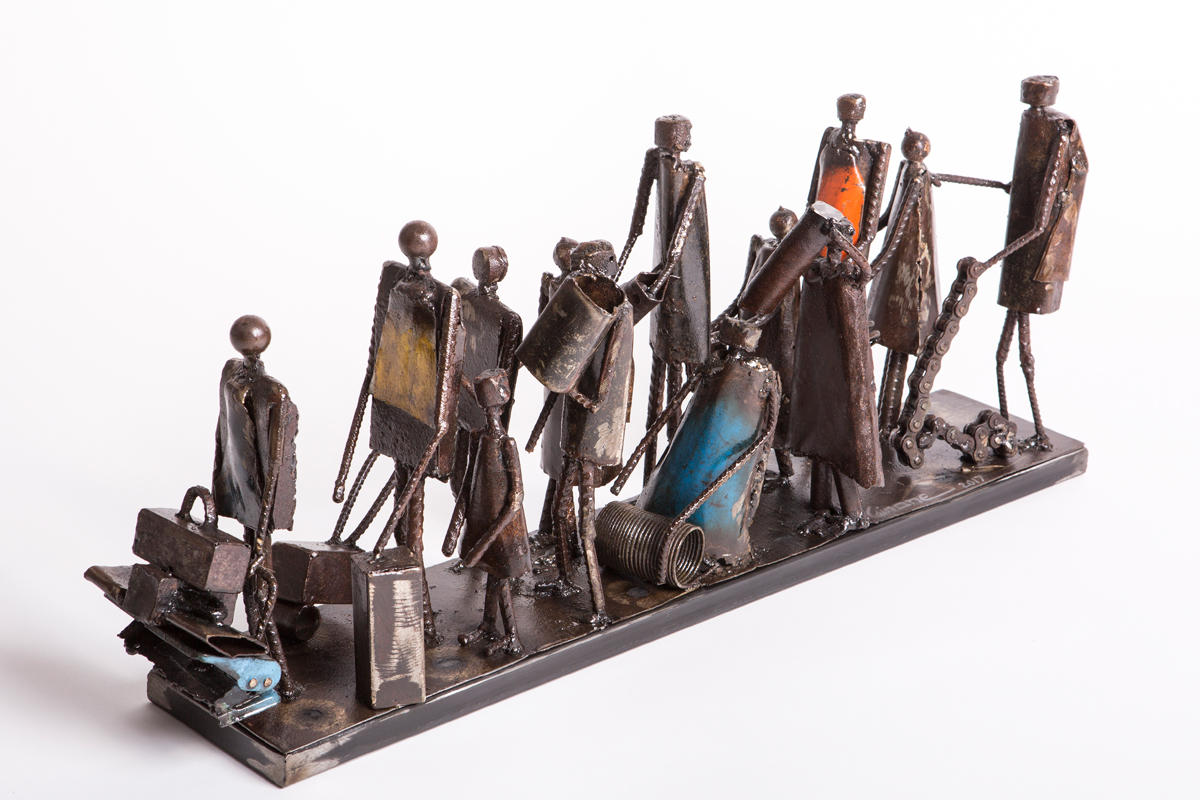Alumna Ginane Makki Bacho Exhibits at Brooklyn Museum
The artist uses her experiences with war and dispossession to shape her work.
Artist and alumna Ginane Makki Bacho has accomplished a great deal since graduating from LAU with a BA in 1982, and completing her MFA in Printmaking and Painting at the Pratt Institute, NY. She has taught Fine Arts for 15 years in Lebanon and the US, and has held several solo as well as collective exhibitions in Beirut, Washington, Dubai, Doha, and Alexandria, among others. Currently exhibiting at the Brooklyn Museum, Bacho spoke to MarCom about her career and the traumatic events that inform her work.
How did you come to exhibit your recent work at the Brooklyn Museum?
About two years ago, I held an exhibition at Saleh Barakat Gallery, titled Civilization, which documented the spread of violence and atrocities in the region. The sculptures, made out of scrap metal, replicated images in the media: tanks mounted by masked gunmen, trucks carrying captives, and motorbikes with riders brandishing weapons and waving flags. I completed this grim picture with a flotilla of small boats overflowing with figures to portray the effect that this violence had on people.
The show featured in the prestigious Artforum magazine, and last April I was invited to give a lecture about my work at a symposium at MIT on the Art of Destruction. Having either seen pictures of my sculptures on the web or the article in Artforum, the Brooklyn Museum approached me to take part in an exhibition about refugees. My boats, they said, were symbolic of events in the last few years.
What will you be exhibiting of your collection, and what is it meant to convey?
The collection (in bronze and scrap metal) is meant to drive home the plight of refugees, which weighs heavily on my mind and that of the world. The sculptures are of people on foot carrying suitcases, or on boats, and embody the despair of those who chose to risk their lives to escape imminent decimation.
Since our childhood, we’ve lived the trauma of Palestinian refugees, and then it was us, the Lebanese, who were fleeing from place to place, during the civil war. But the tremendous impact that the plight of Syrian refugees has had – to me – is beyond description, considering its scale.
You’ve said in your interviews that you don’t work with an audience in mind. Were you surprised by the popularity of your productions?
My work is self-referential, and not intended to please others. Over the course of my career, it has revolved around my experiences, as a witness to various traumatic wars. During the Lebanese civil war, I made sculptures of the shrapnel and bombs that destroyed my home and studio, which I exhibited at Beirut University College [the name for LAU at the time] in 1983, along with seven other graduates from the university.
In the last few years, I’ve shifted from the personal to the global with Civilization and, before that, with Burj Al-Murr, the Egg, and the Holiday Inn – which had become monuments of the civil war. I never produced a work with the intention to sell. This might explain its success!
My only purpose was to record events with the impartiality of a historian. I didn’t seek to embellish the tools of death, as I had when I turned my shrapnel into organic or symbolic shapes, such as the Cedar, back in 1983. I wanted to be as authentic as possible, so that the sculptures would stand as testimonials of this time of our life, its ugliness and destruction.
You’ve worked with several mediums. Any preference?
I enjoy experimenting; every medium enriches me and gives my work a different dimension.
I have been working on sculptures for the last seven or eight years now, with two painting exhibits in between. I would say I’m slightly partial to sculptures, because I started working with metal at a young age, but I do long to go back to etching – which I had started in 1977 – and which I am planning on for next year.
Which work has been most gratifying to you as an artist?
I can’t really choose between my works, as they were born under particular circumstances and at different stages in my life. I made beautiful etchings in 1983 and 1984, and I wish I could do something similar. But I have changed a lot since. I used to be a romantic, a dreamer; not anymore. I am now more of an observer (although I sometimes feel nostalgic for the old good times). I have known wars, exile, illness, and I am trying to alleviate these misfortunes by denouncing them through my work. An artist needs to have a say in this life and, as an activist, I can’t separate my life from my art.
Do you have any other works in progress?
Of course, I have been working nonstop. After the refugees, there might be another story that exposes us – the people – and the fact that we are going backward instead of progressing.
The title of my collection, Civilization, is used pejoratively to signify our decadence. And when I use scrap metal, it’s to convey that we live in a scrap civilization where only weapons and money count, destroying values, countries and eradicating whole populations.
This interview has been condensed and edited.
The exhibition Syria, Then and Now: Stories from Refugees One Century Apart at the Brooklyn Museum will run until January 13, 2019.



